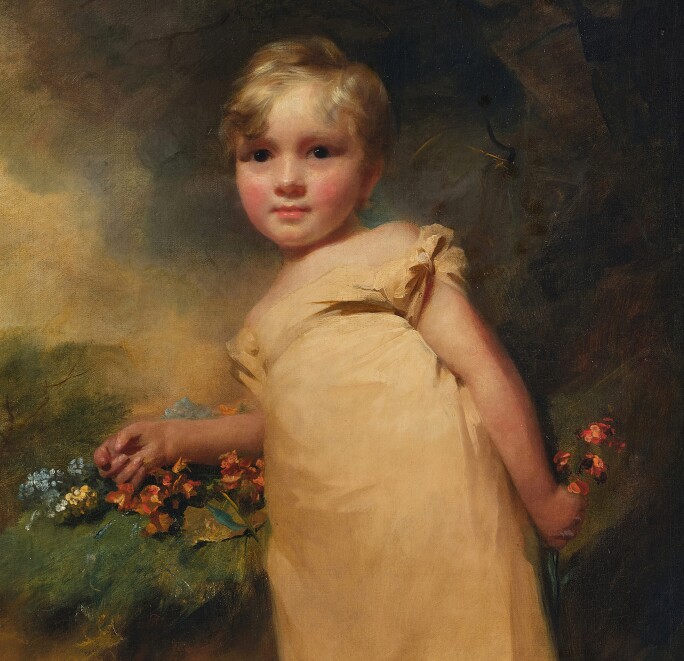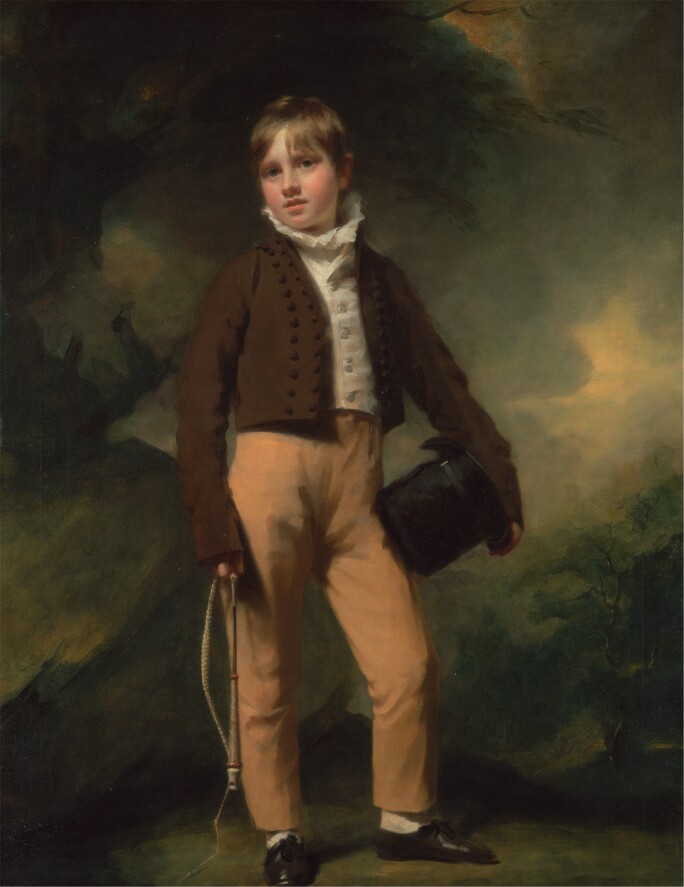
The author of this work, Sir Henry Raeburn, R.A., produced some of the most endearing images of childhood during the Romantic era. Described by David Mackie as "an unusually fine example," Raeburn's portrait of the four or five-year-old William Scott-Elliot of Arkleton, Dumfriesshire, is a superb example of the artist's painterly bravura balanced with a profound level of sensitivity. Raeburn's portraits of children remain amongst the painter's most highly prized works and are rarely encountered on the art market.1
William Scott-Elliot (1811-1901) was born into a family of Scottish landowners. He is known to have practiced law and became a Writer to the Signet in 1833. His mother Margaret Elliot (d. 1816) was the sole heir of her family's ancestral home, the baronial estate of Arkleton located near Langholm, Dumfriesshire. In 1807 she married a Leith merchant named Adam Scott (d. 1821) and their son and heir would adopt both of their names. When the present work was sold by Sotheby's in 1927, the catalogue recounted the sitter's recollections that Raeburn had personally requested to paint him, as his parents were the artist's neighbors (presumably in Edinburgh, where he lived and worked for his entire career). Curiously, the portrait stayed in the Raeburn family's possession and was only later acquired by the sitter in 1877. As Mackie had noted, "It is not clear how he [the sitter] was able to identify this as his own portrait more than sixty years after sitting."
Painted in 1815, this particularly sweet and poetic full-length portrait depicts Scott-Elliot in his robes of infancy, standing proudly and nonchalantly next to a collection of freshly picked flowers. Throughout his career Raeburn excelled in sensitive and playful portraits of children and this example was completed in the same year he became a full member of the Royal Academy.2 Paintings such as these represent changing attitudes surrounding notions of innocence and the increasingly liberal education of children explored by philosophers such as Jean-Jacques Rousseau (1712-1778) during the Enlightenment.3 The fashion in Britain for presenting children in inventive and experimental ways was particularly promoted by the so-called "Fancy Pictures" first painted by the Royal Academy's first president, Sir Joshua Reynolds (1723-1792).4 The youthfulness of Raeburn's sitter is expressed with a heightened sense of whimsy and humor. The cross-legged position of his dainty legs, for example, is a pose usually adopted by grown-men in portraits, not toddlers.

The artist's distinctive brushwork, which makes his portraits immediately recognizable, is evident throughout the canvas. His particularly broad application of paint, in which contours are softened to great effect, adds to the work's informality and charm. The handling of details, such as the brightly colored flowers, are executed with a looseness that can rightly be described as proto-impressionistic. Scott-Elliot's portrait can be compared directly with Raeburn's more costume orientated portrait of Master Quintin McAdam of Vraigengillian (fig. 1), now in the Paul Mellon Collection at the Yale Centre for British Art.5 The Yale painting, also completed in 1815, exhibits the same dark green background with sketchily painted trees, an effect that likewise allows the figure to stand out brightly against these murky depths.
1 The last significant full-length portrait of this caliber was the Portrait of Sir Evan Murray-MacGregor of MacGregor in Tartan, which was sold at Christie's, London, 8 July 2014, lot 64 for £458,500. Before this example, the last comparable painting was The Allen Brothers (Portrait of James and John Lee Allen) formerly with Simon Dickinson Ltd., from whom acquired by the Kimbell Art Museum, Fort Worth, in 2002.
2 A particular fine earlier work is The Paterson Children, dated to 1790-1793, preserved by the National Trust and Polesdon Lacey, Surrey. https://www.nationaltrustcollections.org.uk/object/1246448
3 H-H. Ewers, "Children of Nature, Children of God: Images of Childhood and Children's Literature from the Enlightenment to Romanticism" in The Changing Face of Childhood: British Children's Portraits and their Influence in Europe, exhibition catalogue, M. Neumeister (ed.), London and Frankfurt, 2007, pp. 47–57.
4 M. Postle, Sir Joshua Reynolds, The Subject Pictures, Cambridge 1995, pp. 58–120.
5 Sir Henry Raeburn, R.A., Master Quintin McAdam of Vraigengillian, oil on canvas, 154.9 x 120 cm. Yale Center for British Art, Paul Mellon Collection.; https://collections.britishart.yale.edu/catalog/tms:993